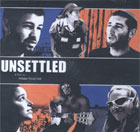
Unsettled 2007
Distributed by Resonance Pictures
Producer n/a
Directed by Adam Hootnick
DVD, color, 80 min.
Jr. High - Adult
Asian Studies, Geography, History, Human Rights, Jewish Studies, Middle Eastern Studies, Multicultural Studies, Political Science, Religious Studies
Date Entered: 01/31/2011
Reviewed by Caron Knauer, La Guardia Community CollegeThis gripping, upsetting, and heart-wrenching documentary tells the story of the Israel Defense Force’s evacuation of its own Jewish settlers on the Gaza Strip. By focusing on five young people—two soldiers, two residents, and a religious filmmaker—as well as presenting various points of view on the withdrawal, director Adam Hootnick contextualizes the history and personalizes the pullout in a deeply compelling and humanistic way.
The first image the viewer sees is a helicopter flying into a training base in southern Israel. It’s July of 2005, and at a media briefing, Tamar, 20, a speaker for the IDF, announces the August mission. She says “There’s no enemy, there’s no victory.” At the training sessions soldiers are instructed to be strong and to not take any pleasure in evicting people from their homes. The young soldiers, including Yuval, 21, express their ambivalence and fear about the work they will have to do in Gaza, which is also known as Palm Beach.
The beauty of the ocean-lined Gaza enchants—it looks as enticing as a travel advertisement for a sun-drenched island. “The land has a spirit,” according to handsome Lior, 20, a lifeguard whose family is about to lose their house. Lior and his friend, the religious Meir, 27, sing and play guitars with friends on the beach. Lior sings “Where should I go? What should I do? Where is there another place that looks like a picture from a dream? At one point, he says, “This is where I live, it’s not a war, it’s not a desert,” but after a mortar goes off, he tells his interviewer, “We surf in the morning and we eat bombs in the night.”
Former Prime Minister Ariel Sharon is blamed for the bombs and for the disengagement. He is called a hypocrite by protesters as he encouraged settlers to populate Gaza in the first place. Ye’ela, a young woman whose sister was killed by a suicide bomber, supports withdrawal. She doesn’t want anyone else to suffer the devastating loss that she has. She agrees, as many in the film do, that it is impossible for Arabs and Israelis to co-exist. Many Israelis express their support of the decision, claiming that it’s the only possible answer to bring peace to the region. Meir says God said Jews cannot make peace with Arabs. Other angry protesters feel that the evacuation is a crime against God and that Israel is treating its own people as the enemy. A rabbi in the street screams, “The Arabs want the whole world to be Muslim. No Jews, no Russians, no Christians.”
Neta, 20, a religious filmmaker from Netzarim, the largest settlement on Gaza, who has been brought up to believe that “Every minute you build in Israel you’re doing something good,” protests the evacuation. And when eviction day arrives, the residents of Netzarim, as expected, passively resist leaving their homes and are carried out by soldiers. A sacred torah carried by several men is taken into the streets, and they proudly hold it high. People dance in front of their homes; a large man cries in revolt. Soldiers have to literally pull people out of their homes, and one soldier cries and takes off his uniform. He can’t go through with it. But still, the evacuation is a success; it takes a week, although, it was expected to take longer.
The cinematography by Hootnick and Mickey Elkeles dazzles, and the reggae-inflected protest songs and the lush, atmospheric original score by Jon Lee entertain and excite. The editing is flawless, and the narrative, enhanced by the sometimes pulsating music, builds like a thriller. All of the points of view expressed in the film incite compassion in the viewer. This beautifully made, profound film is an extraordinary piece of filmmaking. It’s a work of historical art. Awards
- Grand Jury Best Documentary Slamdance, 2007
- Jury Prize Best Documentary, Temecula Valley International Film Festival Audience Award Best Documentary, Florida Film Festival 2007